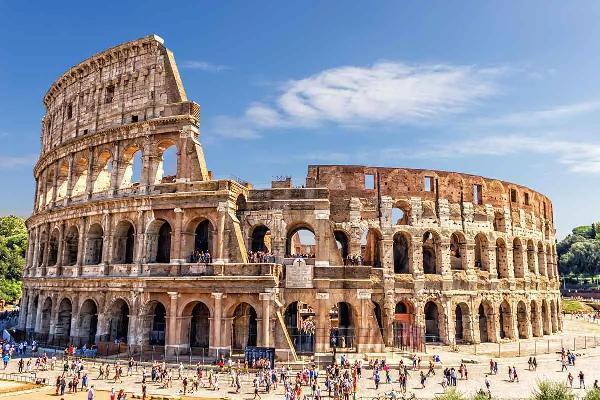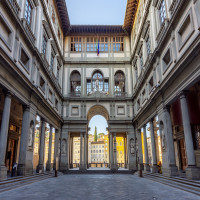Italy: Unveiling Iconic Landmarks, Cultural Treasures, and Natural Splendo

Strong 8k brings an ultra-HD IPTV experience to your living room and your pocket.
Italy, a country renowned for its rich history, vibrant culture, and stunning landscapes, is a traveler's paradise. From ancient ruins to Renaissance art, picturesque coastlines to rolling vineyards, Italy offers a diverse array of experiences that captivate visitors from around the globe. Here, we delve into some of the must-visit places in Italy, starting with one of its most iconic landmarks: the Colosseum.
The Colosseum: Icon of Ancient Rome
The Colosseum stands as a monumental symbol of ancient Rome's grandeur and engineering prowess. Constructed between 70-80 AD under Emperor Vespasian and expanded under his successors, the Colosseum is the largest amphitheater ever built and was used for gladiatorial contests and public spectacles.
Visiting the Colosseum allows travelers to step back in time and imagine the roar of the crowds as gladiators fought for their lives on the arena floor. The structure's impressive architecture, with its series of arches and tiers, offers a glimpse into the engineering marvels of the Roman Empire. Exploring the underground chambers and learning about the complex system of trapdoors and mechanisms used in ancient times adds to the fascination of this UNESCO World Heritage site.
Venice: The Floating City
No visit to Italy is complete without experiencing Venice, the enchanting city built on a network of canals. Known for its romantic ambiance, stunning architecture, and rich cultural heritage, Venice is a place where every corner tells a story.
A gondola ride along the Grand Canal is a quintessential Venetian experience, offering views of elegant palaces, churches adorned with Byzantine mosaics, and bustling squares like Piazza San Marco. The Venice Biennale, one of the most prestigious cultural events in the world, attracts art enthusiasts to explore contemporary works in a city steeped in history.
Florence: Cradle of the Renaissance
Florence, the capital of Italy's Tuscany region, is synonymous with the Renaissance and boasts an unparalleled artistic legacy. The city's skyline is dominated by the red dome of the Florence Cathedral (Duomo), a masterpiece of Gothic architecture designed by Filippo Brunelleschi.
Art lovers flock to the Uffizi Gallery, home to works by Renaissance masters such as Leonardo da Vinci, Michelangelo, and Botticelli. The Pitti Palace and Boboli Gardens showcase the opulence of the powerful Medici family, who patronized some of the greatest artists of their time.
Rome: The Eternal City
Rome, Italy's capital, is a sprawling metropolis where ancient ruins coexist with modern life. The Vatican City, an independent city-state within Rome, is home to St. Peter's Basilica and the Vatican Museums, which house Michelangelo's iconic ceiling frescoes in the Sistine Chapel.
The Roman Forum, once the center of political and social life in ancient Rome, features ruins of temples, basilicas, and government buildings. Nearby, the Pantheon, a marvel of ancient Roman engineering, continues to inspire awe with its perfectly preserved dome and oculus.
Amalfi Coast: A Mediterranean Paradise
The Amalfi Coast, located in southern Italy's Campania region, is celebrated for its dramatic coastline, pastel-colored villages clinging to cliffs, and azure waters. Positano, with its steep streets and pebble beaches, attracts jet-setters and honeymooners seeking a romantic getaway.
The town of Amalfi, from which the coast derives its name, boasts a stunning cathedral with Moorish-influenced architecture and a vibrant piazza where locals and tourists mingle. Ravello, perched high above the sea, offers panoramic views and is renowned for its annual classical music festival held in the gardens of Villa Rufolo.
Tuscany: Rolling Hills and Vineyards
Tuscany epitomizes the rustic charm and pastoral beauty of the Italian countryside. The region's gently rolling hills are blanketed with vineyards producing some of Italy's finest wines, including Chianti and Brunello di Montalcino.
The medieval city of Siena, famous for its Palio horse race held in the Piazza del Campo, transports visitors back to the Middle Ages with its narrow streets and historic buildings. The walled town of San Gimignano is known for its medieval towers, which offer panoramic views of the surrounding countryside.
Cinque Terre: Cliffside Villages
Cinque Terre, a UNESCO World Heritage site on the Ligurian coast, comprises five charming villages perched on rugged cliffs overlooking the Mediterranean Sea. Monterosso al Mare, Vernazza, Corniglia, Manarola, and Riomaggiore are connected by scenic hiking trails that offer breathtaking views of the coastline.
Each village has its own unique character, from Vernazza's bustling harbor to Corniglia's terraced vineyards. Fresh seafood, locally produced wine, and olive oil can be enjoyed at seaside cafes and trattorias nestled among colorful houses adorned with climbing bougainvillea.
Sicily: Island of Contrasts
Sicily, the largest island in the Mediterranean Sea, boasts a diverse cultural heritage shaped by Phoenician, Greek, Roman, Arab, Norman, and Spanish influences. Palermo, the island's capital, is a melting pot of cultures with its bustling markets, Byzantine mosaics, and Arab-Norman architecture.
Mount Etna, Europe's tallest active volcano, looms over the eastern coast and offers opportunities for hiking and skiing. The Valley of the Temples near Agrigento features well-preserved ancient Greek temples overlooking the sea, while the medieval town of Taormina offers panoramic views of the coastline from its ancient Greek theater.
Milan: Fashion and Finance
Milan, Italy's fashion and financial capital, is a dynamic metropolis known for its high-end shopping districts, designer boutiques, and world-class museums. The Gothic Milan Cathedral (Duomo di Milano) dominates the city's skyline with its elaborate facade and spires adorned with statues.
Leonardo da Vinci's masterpiece, "The Last Supper," can be admired at the Santa Maria delle Grazie church, although advance reservations are required. The Teatro alla Scala, one of the world's most famous opera houses, continues to host performances by renowned artists and orchestras.
Pompeii and Herculaneum: Frozen in Time
Pompeii and Herculaneum offer a poignant glimpse into daily life in ancient Rome before the catastrophic eruption of Mount Vesuvius in 79 AD buried these cities beneath a thick layer of volcanic ash. Excavations have revealed remarkably well-preserved homes, temples, and public buildings frozen in time.
Visitors can explore ancient streets lined with stone buildings, public baths adorned with colorful mosaics, and the haunting plaster casts of residents caught in the throes of the disaster. The Villa of the Mysteries in Pompeii features frescoes depicting scenes from ancient Roman religious rites and ceremonies.
Conclusion
Italy's allure lies not only in its iconic landmarks and artistic treasures but also in its diverse landscapes and regional cuisines. Whether savoring a creamy gelato in Florence, exploring ancient ruins in Rome, or soaking up the sun along the Amalfi Coast, every corner of Italy offers a unique blend of history, culture, and natural beauty. From bustling cities to serene countryside, Italy invites travelers to embark on a journey through time and indulge in la dolce vita—the sweet life that embodies the essence of this extraordinary country.
Note: IndiBlogHub features both user-submitted and editorial content. We do not verify third-party contributions. Read our Disclaimer and Privacy Policyfor details.


